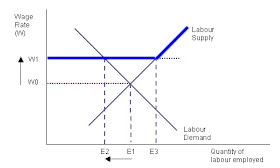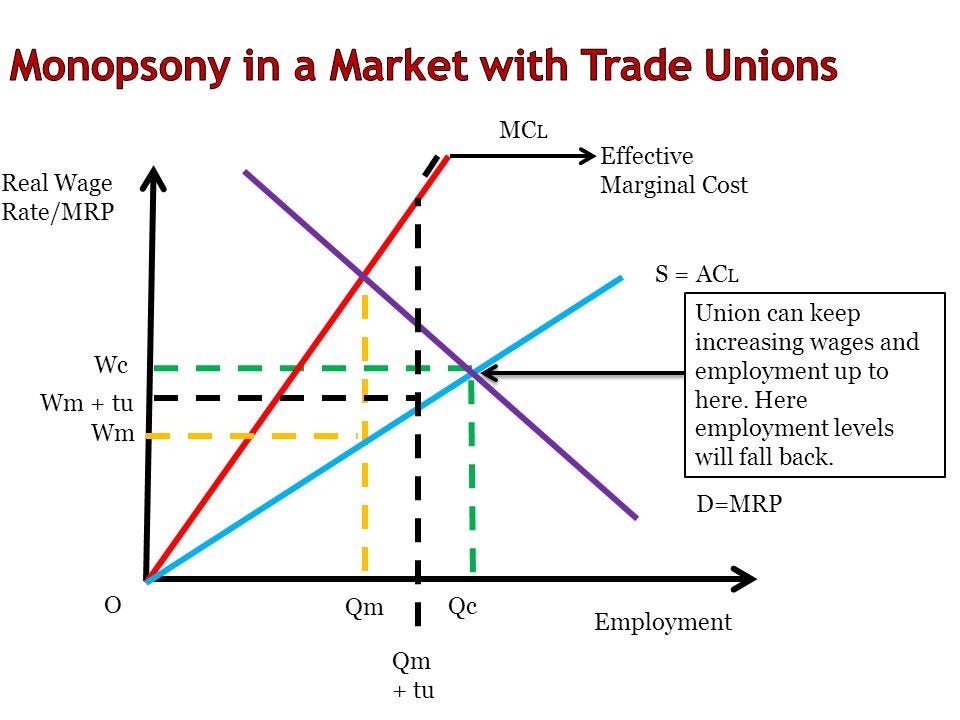Wage Determination and Labour Market Issues
Wages, Trade Unions, NWM, Labour Market Discrimination, etc
Hi All,
Welcome to this week’s edition of the A-Level Economics Newsletter. Our focus today is Wage Determination and Labour Market Issues, a critical topic that blends theoretical principles with real-world applications. Whether you're preparing for an essay or gearing up for a data-response question, this guide is packed with insights, examples, and tips to give you the edge.
Understanding Wage Determination
Wages in a labour market are determined through a complex interplay of market forces, institutional factors, and government policies. At its core, the wage rate is a price: the price of labour. Here’s a breakdown of how wages are influenced:
1. Market Forces: Supply and Demand
Demand for Labour:
Firms demand labour to produce goods and services. The demand curve for labour is downward sloping, reflecting the Law of Diminishing Marginal Returns: each additional worker adds less value to the firm's output.
Example: A tech firm hiring software engineers will initially see large productivity gains from new employees, but as the team grows, additional workers contribute less marginal value.
Supply of Labour:
Workers supply labour based on their opportunity cost, factoring in wages, working conditions, and leisure time. The supply curve is typically upward sloping, as higher wages attract more workers.
Equilibrium Wage:
The equilibrium wage is set where the supply and demand curves intersect.
Example: In the UK nursing sector, an ageing population increases demand for healthcare, pushing wages higher.
2. Elasticity of Labour Supply and Demand
Elasticity affects how wages respond to changes in market conditions:
Inelastic Demand for Labour: If workers are essential and substitutes are unavailable (e.g., nurses, doctors), wages tend to be stable even during economic fluctuations.
Elastic Labour Supply: Jobs requiring minimal training (e.g., retail assistants) face more wage competition since workers can enter these roles easily.
Role of Government and Institutions
1. National Minimum Wage (NMW)
Purpose: To prevent worker exploitation and ensure a basic standard of living.
Effects:
Positive: Raises incomes for low-paid workers, reduces poverty, and can boost consumption in the economy.
Negative: May increase unemployment if firms cannot afford the higher wages, particularly in industries with low profit margins (e.g., hospitality).
Case Study: In 2023, the UK raised the NMW for workers aged 23+ to £10.42/hour. Studies found minimal job losses due to strong post-pandemic labour demand.
2. Trade Unions
Function: Trade unions negotiate higher wages and better working conditions for their members.
In Monopsonistic Markets: Unions can raise wages and employment simultaneously by countering employer power.
Example: The British Medical Association (BMA) secured a pay increase for junior doctors in 2023, improving recruitment and retention.
Labour Market Structures
Labour markets operate under various competitive conditions, each with distinct wage outcomes:
1. Perfectly Competitive Labour Markets
Characteristics:
Many small firms and workers, each with no individual market power.
Firms are wage takers, hiring at the market equilibrium wage.
Example: Seasonal agricultural workers in regions with high labour mobility.
Diagram: A horizontal supply curve for the firm, with market equilibrium wage determined by supply and demand.
source: learneconomics
Minimum Wage Effect:
Trade Union Effect:
2. Monopsony Labour Markets
Characteristics:
A single dominant employer sets wages below the equilibrium.
Firms maximise profits where Marginal Revenue Product (MRP) = Marginal Cost of Labour (MCL).
Example: Amazon in certain regions, where it dominates job opportunities for warehouse workers.
Diagram: The monopsony equilibrium shows lower wages and employment compared to perfect competition.
Impact of a Minimum Wage in a Monopsony:
A minimum wage can increase both employment and wages by preventing monopsonistic exploitation.
Trade Union Effect:
Key Labour Market Issues
1. Wage Inequality
Causes:
Differences in education and skills.
Gender pay gaps: In the UK, women earned 14.9% less per hour than men on average in 2023.
Regional disparities: Workers in London earn significantly more than those in the North East.
Policies to Reduce Inequality:
Improving access to education and training.
Strengthening anti-discrimination laws.
2. The Gig Economy
Definition: Flexible jobs with short-term contracts (e.g., Uber drivers).
Issues:
Low wages and job insecurity.
Limited bargaining power for workers.
Governments and unions are exploring ways to improve gig worker protections.
Real-World Examples for Essays
UK National Minimum Wage:
A long-term success in reducing extreme low pay without significant unemployment effects.
The NHS and Monopsony Power:
The NHS uses its buying power to set wages for healthcare workers, leading to disputes when wages lag behind inflation.
Amazon Warehouse Workers:
Amazon has faced criticism for low wages and challenging working conditions, highlighting monopsonistic practices.
Exam Preparation: Tips and Tricks
Key Diagrams:
Supply and demand curves for competitive and monopsonistic markets.
Impact of minimum wages and trade unions on equilibrium.
Evaluation Strategies:
Discuss short-run vs. long-run effects of policies like the minimum wage.
Highlight unintended consequences, such as automation replacing low-skilled workers.
Synoptic Links:
Labour markets tie into other macroeconomic topics:
Unemployment trends.
Government intervention and market failure.
Globalisation’s impact on wages.
Looking Ahead
Next week, we’ll explore the Distribution of Income and Wealth, focusing on policies to reduce poverty and inequality. Expect a detailed breakdown of Lorenz curves, the Gini coefficient, and case studies from across the globe.
That’s all for this week.
Best,
Sam
A-Level Economics Weekly










